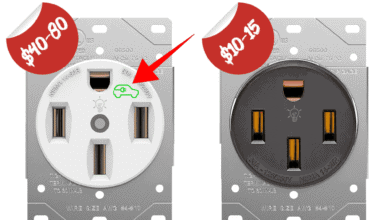Difference Between Conductor, Semiconductor and Insulator
What is the Difference Between Conductors, Semiconductors and Insulators?
The main difference between the conductor, semiconductor & insulator is in its conduction state. The conductors always conduct electric current while the insulators do no conduct. However, semiconductor conducts & blocks at different conditions.
What is a Conductor?
In Electrical & Electronics engineering, a conductor is a type of material that allows the flow of charge otherwise known as electrical current. Most common electrical conductors are made from metals. Such materials allow the current flow due to the presence of free electron or ions which starts moving when voltage is applied.
The conductors have very low electrical resistance i.e. the opposition to the current flow & depend on the length & width of the conductor. It increases with increase in temperature.
- Related Post: Difference Between Conductor and Superconductor
What is Semiconductor?
Semiconductors are materials that have conductivity in-between conductors and insulators. They can block or allow the current flow providing total control over it. They are mostly modified by adding impurities called doping. It modifies its properties like unidirectional current flow or amplification or energy conversion etc.
The electrical conduction inside semiconductors is due to the movement of electrons & holes.
- Related Post: Difference Between Current and Voltage
What is Insulator?
An insulator is a material that has very high electrical resistance & it does not allow the flow of current. There are no free electrons in insulators thus they do not conduct electricity. Thus they are used for protection against shock.
- Related Post: Difference Between Voltage and EMF?
Differences Between Conductors, Semiconductors & Insulators:
| Characteristics | Conductor | Semiconductor | Insulator |
| Definition | A conductor is a material that allows the flow of charge when applied with a voltage. | A semiconductor is a material whose conductivity lies between conductor & insulator | An insulator is a material that does not allow the flow of current. |
| Temperature Dependence | The resistance of a conductor increases with an increase in temperature. | The resistance of a semiconductor decrease with increases in temperature. Thus it acts as an insulator at absolute zero. | Insulator has very high resistance but it still decreases with temperature. |
| Conductivity | The conductors have very high conductivity (10-7 Ʊ /m), thus they can conduct electrical current easily. | They have intermediate conductivity ((10-7 Ʊ /m to 10-13 Ʊ /m), thus they can acts as insulator & conductor at different conditions. | They have very low conductivity (10-13 Ʊ /m), thus they do not allow current flow. |
| Conduction | The conduction in conductors is due to the free electrons in metal bonding. | The conduction in semiconductor is due to the movement of electron & holes. | There are no free electrons or holes thus, there is no conduction. |
| Band gap | There is no or low energy gap between the conduction & valance band of a conductor. It does not need extra energy for the conduction state. | The band gap of semiconductor is greater than the conductor but smaller than an insulator i.e. 1 eV. Their electrons need a little energy for conduction state. | The band gap in insulator is huge (+5 eV), which need an enormous amount of energy like lightning to push electrons into the conduction band. |
| Resistivity | Low (10-5 Ω/m) | Normal (10-5Ω/m to 105 Ω/m) | Very High (105 Ω/m) |
| Coefficient of Resistivity | It has positive coefficient of resistivity i.e. its resistance increase with temperature | It has negative coefficient of resistivity. | The coefficient of resistivity of an insulator is also negative but it has very huge resistance. |
| Absolute Zero | Some special conductors turn into superconductors when supercooled down to absolute zero while other have finite resistance. | The semiconductors turn into insulator at absolute zero. | The insulator’s resistance increase when cooled down to absolute zero. |
| Valence Electron in Outer Shell | 1 Valence electron in outer shell. | 4 Valence electron in outer shell. | 8 Valence electron in outer shell. |
| Examples | Gold, Copper, Silver, Aluminum etc | Silicon, Germanium, Selenium, Antimony, Gallium Arsenide (known as semi insulator),Boron etc. | Rubber, Glass, Wood, Air, Mica, Plastic, Paper etc. |
| Application | The metals like iron & copper etc. that can conduct electricity are made into wires and cable for carrying electric current. | Semiconductors are used every day electronic devices such as cellphone, computer, solar panel etc as switches, energy converter, amplifiers, etc. | The insulators are used for protection against high voltages & prevention of electrical short between cables in circuits. |
Related Posts:
- Difference Between Real Ground and Virtual Ground
- Difference Between Active and Reactive Power
- Difference Between a Battery and a Capacitor
- Main Difference between Fuse and Circuit Breaker
- Main Difference between Contactor and Starter






